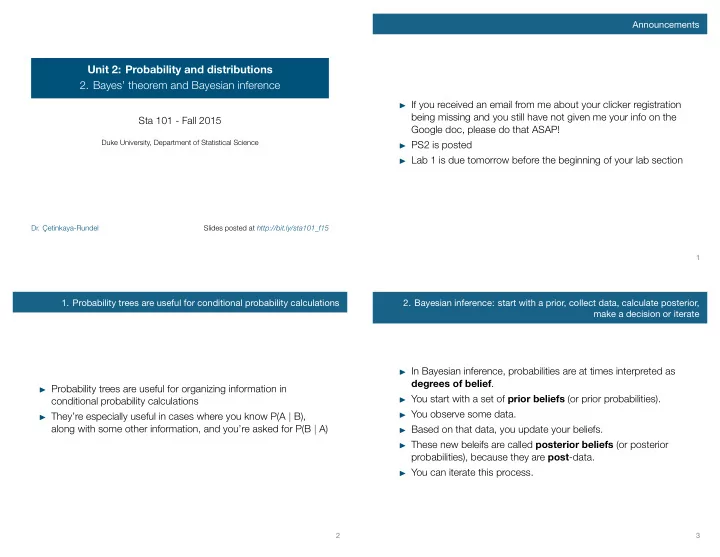

Announcements Unit 2: Probability and distributions 2. Bayes’ theorem and Bayesian inference ▶ If you received an email from me about your clicker registration being missing and you still have not given me your info on the Sta 101 - Fall 2015 Google doc, please do that ASAP! Duke University, Department of Statistical Science ▶ PS2 is posted ▶ Lab 1 is due tomorrow before the beginning of your lab section Dr. Çetinkaya-Rundel Slides posted at http://bit.ly/sta101_f15 1 1. Probability trees are useful for conditional probability calculations 2. Bayesian inference: start with a prior, collect data, calculate posterior, make a decision or iterate ▶ In Bayesian inference, probabilities are at times interpreted as degrees of belief . ▶ Probability trees are useful for organizing information in ▶ You start with a set of prior beliefs (or prior probabilities). conditional probability calculations ▶ You observe some data. ▶ They’re especially useful in cases where you know P(A | B), along with some other information, and you’re asked for P(B | A) ▶ Based on that data, you update your beliefs. ▶ These new beleifs are called posterior beliefs (or posterior probabilities), because they are post -data. ▶ You can iterate this process. 2 3
Dice game Prior probabilities We’ll play a game to demonstrate this approach: ▶ At each roll I tell you whether you won or not (win = ≥ 4 ) ▶ Two dice: 6-sided and 12-sided – P(win | 6-sided die) = 0.5 → bad die – P(win | 12-sided die) = 0.75 → good die – I keep one die on the left and one die on the right ▶ The two competing claims are ▶ The “good die” is the 12-sided die. H 1 : Good die is on left ▶ Ultimate goal: come to a class consensus about whether the die H 2 : Good die is on right on the left or the die on the right is the “good die” ▶ Since initially you have no idea which is true, you can assign equal prior probabilities to the hypotheses ▶ We will start with priors, collect data, and calculate posteriors, and make a decision or iterate until we’re ready to make a P( H 1 is true) = 0.5 P( H 2 is true) = 0.5 decision 4 5 Rules of the game Hypotheses and decisions Truth ▶ You won’t know which die I’m holding in which hand, left (L) or Decision L good, R bad L bad, R good right (R). left = YOUR left Pick L You get candy! You lose all the candy :( ▶ You pick die (L or R), I roll it, and I tell you if you win or not, where winning is getting a number ≥ 4. If you win, you get a Pick R You lose all the candy :( You get candy! piece of candy. If you lose, I get to keep the candy. ▶ We’ll play this multiple times with different contestants. ▶ I will not swap the sides the dice are on at any point. Sampling isn’t free! At each trial you risk losing pieces of candy if you lose (the die comes ▶ You get to pick how long you want play, but there are costs up < 4). Too many trials means you won’t have much candy left. associated with playing longer. And if we spend too much class time and we may not get through all the material. 6 7
Data and decision making Posterior probability Choice (L or R) Result (win or loss) Roll 1 ▶ Posterior probability is the probability of the hypothesis given the observed data: P(hypothesis | data) Roll 2 ▶ Using Bayes’ theorem Roll 3 Roll 4 P ( hypothesis and data ) P ( hypothesis | data ) = Roll 5 P ( data ) P ( data | hypothesis ) × P ( hypothesis ) Roll 6 = P ( data ) Roll 7 ... What is your decision? How did you make this decision? 8 9 3. Posterior probability and p-value do not mean the same thing Calculate the posterior probability for the hypothesis chosen in the first roll, and discuss how this might influence your decision for the next roll. ▶ p-value : P(observed or more extreme outcome | null hypothesis is true) – This is more like P(data | hyp) than P(hyp | data). ▶ posterior : P(hypothesis | data) ▶ Bayesian approach avoids the counter-intuitive Frequentist p-value for decision making, and more advanced Bayesian techniques offer flexibility not present in Frequentist models ▶ Watch out! – Bayes : A good prior helps, a bad prior hurts, but the prior matters less the more data you have. – p-value : It is really easy to mess up p-values: Goodman, 2008 10 11
Summary of main ideas Application exercise: 2.2 Bayesian inference for drug testing 1. Probability trees are useful for conditional probability calculations 2. Bayesian inference: start with a prior, collect data, calculate See the course website for instructions. posterior, make a decision or iterate 3. Posterior probability and p-value do not mean the same thing 12 13
Recommend
More recommend